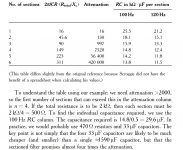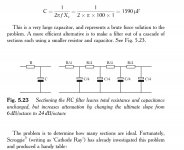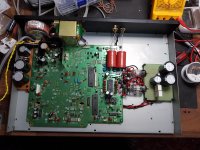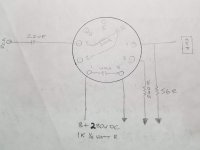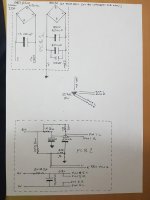So I just finished another SRPP built onto a TDA CDP, Ive done many of these but this one seems to have a noisy Anode supply, if I grab it the noise drops by about 90%. The only thing different with this one is the transformers are now 280v DC where as all my others have been 180v DC, so ive had to change the caps, im using 4x 470uf. Ive tried twisted, non twisted, running cable around the chassis, grounded the chassis and the star 0v point I created but nothing helps like grabbing the cable. The heater supply seems fine, so after reading many posts here I found one that recommended a multiple CRC and that fixed the hum albeit on a different design. I had a quick look at Morgans valve book and he has a table by 'Cathode Ray' (see attached) that shows how many sections and what size caps to use for a stated ripple rejection at 2 frequencies. The circuit im using calls for a CRC with a single 1 to 1k2 R.
1. Do I need to adhere to a specific size of cap?
2. Should I know what frequency the hum is and how much rejection I need?
3. is their a difference between CRC and RCRC? The book shows an example with a resistor first not a capacitor.
4. Do I nee 2W resistors when the circuit only draws 2ma?
It seems most people just use whats on hand and use caps way bigger than whats needed looking at this table. I have some 100uf 450v caps, I intend to buy some 300R's but Im not sure what power rating, its been suggested that the smaller 1/4 watt jobs I use arnt really suitable due to the voltage. Hopefully this isnt to mundane to post here as the noise is driving me mad!
1. Do I need to adhere to a specific size of cap?
2. Should I know what frequency the hum is and how much rejection I need?
3. is their a difference between CRC and RCRC? The book shows an example with a resistor first not a capacitor.
4. Do I nee 2W resistors when the circuit only draws 2ma?
It seems most people just use whats on hand and use caps way bigger than whats needed looking at this table. I have some 100uf 450v caps, I intend to buy some 300R's but Im not sure what power rating, its been suggested that the smaller 1/4 watt jobs I use arnt really suitable due to the voltage. Hopefully this isnt to mundane to post here as the noise is driving me mad!
Attachments
1. Do I need to adhere to a specific size of cap?
First cap capacitance should be less or equal than the second cap, never more.
First cap is the most solicited, choose it with long life characteristics, better temperature grade >= 105C° or higher, and indeed with a worse ESR than the second cap.
Yes. CRC is a reservoir capacitor followed by a CR filter, as used in power supplies. RCRC is a two-section low pass filter, as used in circuits. The information on RCRC is used if you want to build CRCRC for extra hum reduction - assuming good grounding and construction techniques have been used.DawgNo1 said:3. is their a difference between CRC and RCRC? The book shows an example with a resistor first not a capacitor.
Thanks for all the replies guys, just got in from work, looks like I may need to do some more testing and find out what's going on, I don't want to keep rebuilding this thing only to find Im not getting anywhere. I will post some pics of the circuit once I've drawn it out, I don't understand why I've never had any probs before as I've done nothing different other than the bigger transformer.
Try a steel box around the transformer. Steel mesh will do, I use the stuff from the concrete department from the home store. Comes in 4x8 sheets. Cut with metal shears. Bend two flanges in each piece with my fingers over the back steps, tie together with wire twists. Keeps magnetic flux in, lets air pass through. Steel solid wire used for tieing re-bar together holds the wire twists better.I don't understand why I've never had any probs before as I've done nothing different other than the bigger transformer.
Last edited:
Try a steel box around the transformer. Steel mesh will do, I use the stuff from the concrete department from the home store. Comes in 4x8 sheets. Cut with metal shears. Bend two flanges in each piece with my fingers over the back steps, tie together with wire twists. Keeps hum in, lets air pass through. Steel solid wire used for tieing re-bar together holds the wire twists better.
Thanks! When I say bigger transformer I meant higher voltage, the transformer is about the same size well it must be a bit bigger for the extra volts but I would be surprised if that is the problem, my first thought was grounding as I'm grounding the wire picking it up.
Different models transformer have different levels of flux leakage. Flux Leakage might deteriorate even on a similar model number due to cost reductions. I tried to show you a picture of the steel mesh stuff, but Home Depot shows me 4"x4" mesh in 150' rolls then crashes my browser 3 times. It has holes about 4 mm diameter, is stamped out all twisty which makes it bendable. Maybe they call it expanded metal, but search that got me a bunch of playground equipiment. It is in stock at my HD near the cement bags & grout. Don't buy aluminum, it doesn't stop magnetic flux.
I buy junk Peavey amps for my projects because their transformers have a copper band soldered around them, are behind a steel bulkhead and don't hum. But they didn't start until after tubes were gone. Equivalent quality Dynaco tube transformers come in chassis that go for $650 junk.
I buy junk Peavey amps for my projects because their transformers have a copper band soldered around them, are behind a steel bulkhead and don't hum. But they didn't start until after tubes were gone. Equivalent quality Dynaco tube transformers come in chassis that go for $650 junk.
Last edited:
Different models have different levels of flux leakage. Might deteriorate even on a similar model number due to cost reductions. I tried to show you a picture of the stuff, but Home Depot shows me 4"x4" mesh in 150' rolls then crashes my browser 3 times. It has holes about 4 mm diameter, is stamped out all twisty which makes it bendable. Maybe they call it expanded metal, but that got me a bunch of playground equipiment. It is in stock at my HD near the cement bags & grout.
Lol, thanks indianajo, I know the stuff you mean and I guess it creates a faraday cage. We have it in B&Q no doubt, I need to test if thats the problem but maybe I have to do it to test!
Yes. CRC is a reservoir capacitor followed by a CR filter, as used in power supplies. RCRC is a two-section low pass filter, as used in circuits. The information on RCRC is used if you want to build CRCRC for extra hum reduction - assuming good grounding and construction techniques have been used.
I like the sound of extra hum reduction DF96, I think this is an anode supply Morgan Jones is talking about and if it reduces hum by going RCRCRCRC then maybe its a good idea anyway? I was just wondering if the size of the capacitor is critical, the table shows really small caps for X magnitude of filtration, I dont mind overkill if its not detrimental to the design criteria, unfortunately I dont understand design, I just want quiet.
Attachments
If the hum is 50HZ, it is not a power supply issue, assuming you use a bridge rectifier, it will be a grounding/earthing issue.
I think I need to do even more research but thank you!
The size of the capacitor is critical in the sense that a larger capacitor gives better smoothing. Whether this reduces hum depends on what is causing the hum.
Is smoothing different to ripple rejection? The way I read it is that ripple rejection is related to hum. I understand I need to find out where this hum is originating though.
Smoothing and ripple rejection are the same thing. They are sources of hum. They are not the only sources of hum, which is why increasing them does not always reduce hum.
Ah thanks for clearing that up, Ive been building stuff for many years with help from this place but I dont really have the know how or brains to understand a lot.
Ive just started drawing my circuit and I realised I didnt change my diodes for the new voltage, could this be the problem, I will source some new ones now, Im using MUR820 and they are 200v.
ok, a picture paints and all that....
I forgot to draw a 47uf 100v lytic across the 47K elevation circuit....
All of the 0V points go to a copper loop at the foot of the 2 valves, AC feeds to pcb1 are aprox. 2", DAC output to tube is kept very short, under 2". The other thing that is different from my other builds is the new elevated heater circuit, I did bypass this and connected pin 4 to star 0V. There is no earth due to this CDP design, I did try an earth connection.....
I forgot to draw a 47uf 100v lytic across the 47K elevation circuit....
All of the 0V points go to a copper loop at the foot of the 2 valves, AC feeds to pcb1 are aprox. 2", DAC output to tube is kept very short, under 2". The other thing that is different from my other builds is the new elevated heater circuit, I did bypass this and connected pin 4 to star 0V. There is no earth due to this CDP design, I did try an earth connection.....
Attachments
You don't have .01 uf ceramic caps across the electrolytics after either bridge. Rectifier diodes produce sharp edges of 0.7 v as they turn on & off, these round those out. Vertical edges on a scope have fourier analysis components in the megahertz. On every dynaco product I own. Rated at 1000 V since spikes on AC lines can hit 1300 v from shutoff of heating/air motors.
The big electrolytics have so much self inductance from being wound up that the capacitance in the megahertz is very low.
You can cut the V rating on the caps if you put a MOS supressor after the fuse and before the transformer primary. Say, ones rated at 350 vac or more, since you live in the 240 vac zone. Those blue things you see with the slash S on them in a pcat power supply after the fuse. I can't get 1000 v ceramic caps anymore, the best I can find stocked at farnell is 500. Those are $1 and about 10x the size what the .01 1000 v ones from the sixties were.
The big electrolytics have so much self inductance from being wound up that the capacitance in the megahertz is very low.
You can cut the V rating on the caps if you put a MOS supressor after the fuse and before the transformer primary. Say, ones rated at 350 vac or more, since you live in the 240 vac zone. Those blue things you see with the slash S on them in a pcat power supply after the fuse. I can't get 1000 v ceramic caps anymore, the best I can find stocked at farnell is 500. Those are $1 and about 10x the size what the .01 1000 v ones from the sixties were.
Last edited:
- Status
- This old topic is closed. If you want to reopen this topic, contact a moderator using the "Report Post" button.
- Home
- Amplifiers
- Power Supplies
- choosing capacitors for a crc filter
